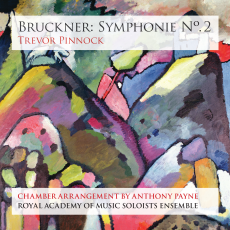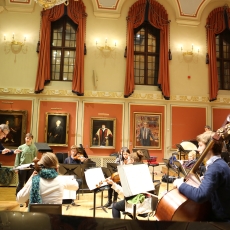Royal Academy of Music Soloists Ensemble & Trevor Pinnock - Bruckner: Symphonie No. 2 - SA-CD.net
In 1918 Arnold Schoenberg formed his 'Verein für
musikalische Privataufführungen'
(Society
for Private Musical Performance) as a reaction against the commercialisation of
music in post-war Vienna. At these private concerts a wide variety of
contemporary works by such composers as Ravel, Debussy, Bartok, Mahler and
Johann Strauss were performed in chamber scoring. Many of the arrangements were
made by Schoenberg's pupils including the familiar names of Anton Webern and
Alban Berg whose substantial arrangement of the popular waltz 'Wine, Women and
Song' by Johann Strauss II is the second item on this new Linn SACD -
surprisingly it is omitted from the front cover of the jewel box.
Though
the Royal Academy of Music students have previously recorded a chamber version
of Mahler's 4th Symphony as arranged by Schoenberg's colleagues Benno Sachs and
Erwin Stein (Mahler: Symphony
No. 4 - Pinnock) this intriguing arrangement of Bruckner's
Second Symphony is a new one by the composer Anthony Payne, perhaps most
well-known for his realisation of Elgar's 3rd Symphony. The idea for a chamber
arrangement of Bruckner's 2nd Symphony came from the Royal Academy of Music's
Principal, Jonathan Freeman-Attwood, and in the liner notes with this disc
Anthony Payne gives an honest and amusing account of how he was persuaded to
undertake this daunting commission that took him five months of hard work to
complete.
There
is no doubt that Payne's version is most successful in bringing a Schubertian
grace and clarity to the piece whilst allowing it to remain unmistakeably as
the work of Bruckner. Perhaps only his decision to omit repeats in the scherzo
- thus reducing it to a mere 6'.09" - might be considered questionable. For
this performance the conductor Trevor Pinnock studied Bruckner's own manuscript
score before deciding on which of the many revisions to incorporate in his
performing version of one of the composer's most neglected symphonies. His
tempo choices seem well-judged and especially persuasive in the eloquent slow
movement.
However,
without wishing in any way to belittle the efforts of the arranger, conductor
and the splendid players of the RAMSE, one is left wondering how often, in this
day and age, one would wish to listen to Bruckner's 2nd Symphony as presented
here rather than on one of the many outstanding full orchestral versions
available. Nevertheless, whatever one's view is on arranging this symphony for
a group of 20 players, there is no doubt about the exceptionally high standard
of execution from the accomplished young musicians of the Royal Academy of
Music Soloists Ensemble. All acquit themselves superbly; displaying a
confidence and accuracy that would put many professional orchestras to shame.
The
fill-up, of the aforementioned Strauss waltz, is beguilingly played with the
distinctive sound of the harmonium bringing an old-world charm that conjures up
the café society of fin de siècle Vienna. The recording, made in St. Georges,
Bristol last year and engineered by Philip Hobbs, is bright and clear with a
pleasing ambience.
This
is a most enjoyable realisation of Schoenberg's vision that will definitely
appeal to those whose curiosity is aroused by chamber reductions of the
symphonic repertoire.


